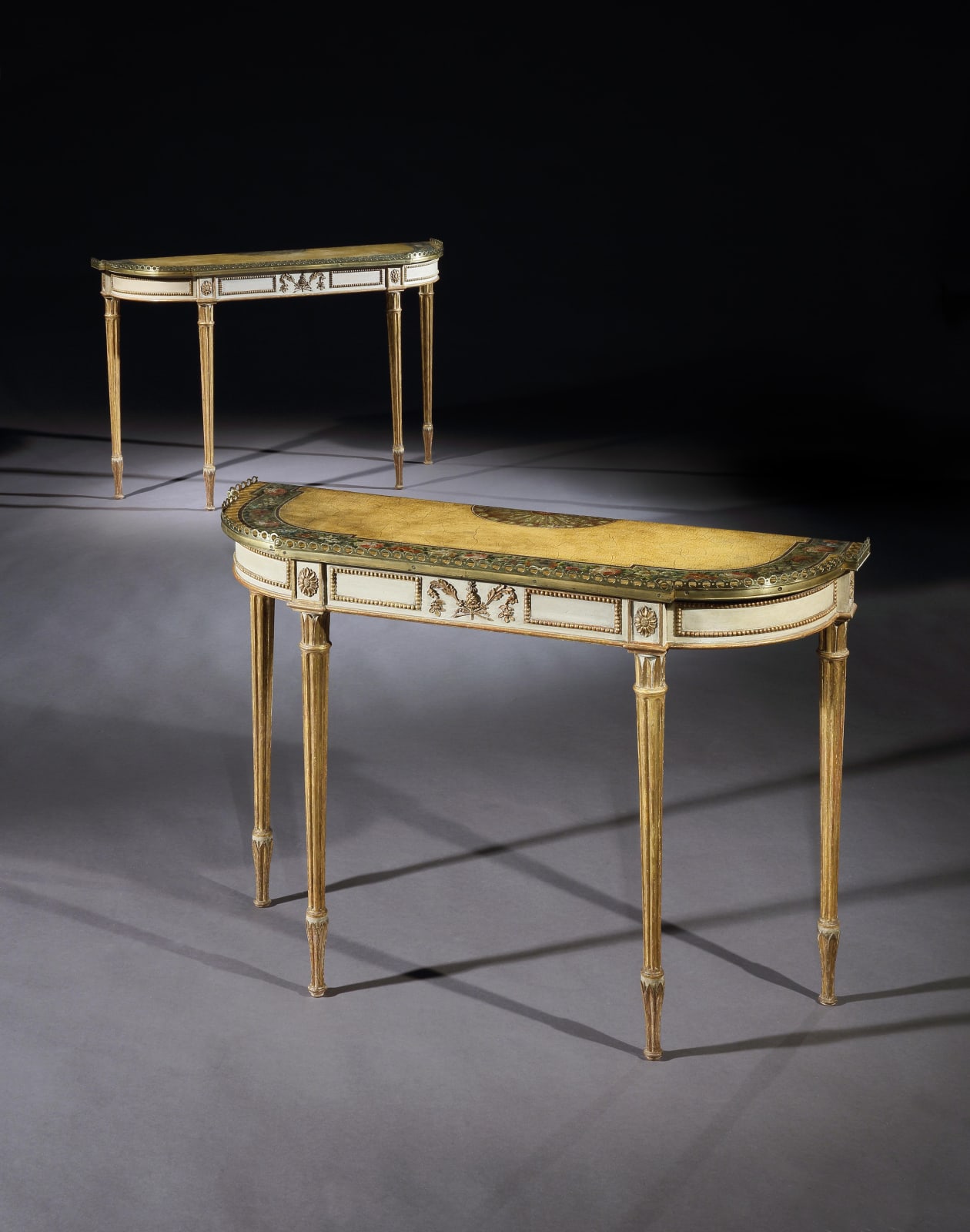A PAIR OF GEORGE III PAINTED AND GILDED SIDE TABLES ATTRIBUTED TO SEDDON & SONS
Height: 32” / 82cm
Width: 44” / 111cm
Depth: 13” / 35cm
Provenance
Mrs Pleydell Bouverie
Julians Park: Hertfordshire
Literature
Christopher Gilbert in “Seddon, Sons & Shackleton”, Furniture History, 1997, pp. 1–29, figs. 3 and 5–6.
A Fine Pair of Late Eighteenth-Century Polychrome and Giltwood Side Tables, Attributed to Seddon & Sons
This elegant and finely executed pair of late eighteenth-century side tables is a rare survival of neoclassical English painted furniture, attributed to the distinguished London cabinetmakers Seddon & Sons. The shaped rectangular tops are bordered by finely cast pierced brass galleries, while the friezes are painted in white ochre and embellished with polychrome floral decoration, delicately heightened with gilt. The design is both classically inspired and visually vibrant, with painted ornament that is original—a rare and remarkable survival.
Each table stands on slender, tapering reeded legs, headed by carved and gilded palmette motifs, referencing Greco-Roman design and exemplifying the late Georgian enthusiasm for refined antiquity. The controlled use of classical ornament, balanced proportions, and sophisticated surface decoration align closely with the highest standards of London cabinetmaking in the 1780s and 1790s.
Seddon & Sons: Pioneers of Decorative Painted Furniture
The design and execution of these tables strongly support an attribution to Seddon & Sons, later Seddon, Sons & Shackleton, one of the largest and most accomplished cabinet-making firms in late eighteenth-century London. Founded by George Seddon, who was appointed Master of the Joiners’ Company in 1795, the firm was known for its large-scale operation from Aldersgate Street, where over 400 craftsmen were employed at its height.
Seddon’s output was characterised by refined painted furniture in the neoclassical taste, often incorporating delicate polychrome ornament and richly figured veneers. Their collaborations with leading architects and designers, including Henry Holland, placed them at the forefront of fashionable interiors of the period. Their clients included members of the royal family and aristocracy, and commissions were completed for prestigious interiors such as St James’s Palace and Windsor Castle.
Documented Parallels and Painted Decoration
The polychrome painted tops with ‘flowered’ borders seen on the present tables bear a close resemblance to documented works by Seddon, Sons & Shackleton. A similar decorative scheme appears on a pair of card tables and a matching Pembroke table supplied to Richard Hall Clarke for Bridwell House, Devon, delivered by the firm on 5 April 1793 at a cost of £25. These are decorated with trailing flowers including convulvulus, closely echoing the scrolling floral borders found here.
Likewise, the use of an ivory-toned ground beneath the floral work—seen on these tables—is a characteristic technique employed by Seddon. It appears again under the peacock-feathered borders of a card table supplied by the firm to D. Tupper for Hauteville House, Guernsey. Both commissions are discussed by Christopher Gilbert in “Seddon, Sons & Shackleton”, Furniture History, 1997, pp. 1–29, figs. 3 and 5–6.
These parallels strongly reinforce the attribution and place this pair of tables within the broader context of the firm’s most refined neoclassical painted output.
Provenance and Preservation
Importantly, the painted and gilded decoration on this pair is original, making them an exceptional survival. Unlike many comparable pieces that have been repainted or over-restored, these retain their delicate colour palette and surface texture, offering a vivid glimpse into the decorative language of late Georgian taste.
One table bears the printed trade label of Bartlett and Colling, respected early twentieth-century fine art dealers known for their handling of high-quality English furniture—attesting to the long-held appreciation of these pieces as works of notable quality and craftsmanship.
